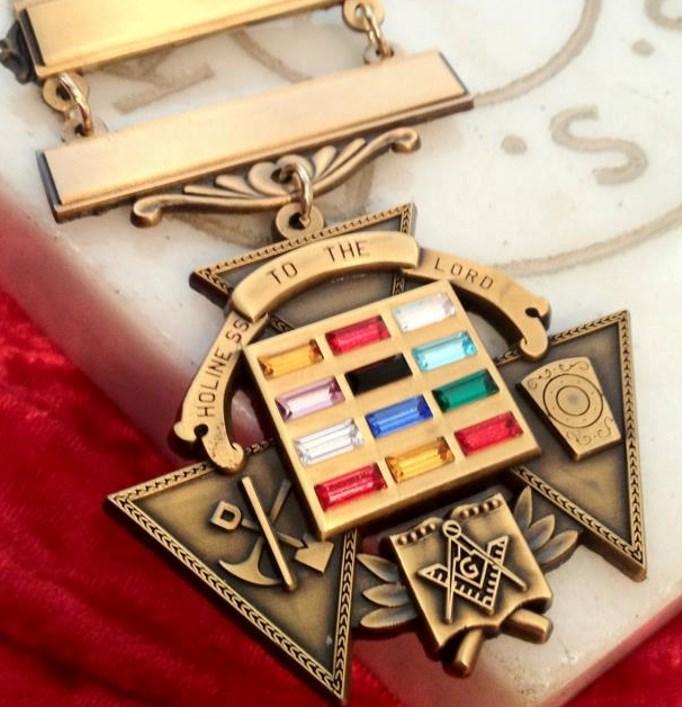
5 minute read
Old Practices
In the UK, very few also said to hold within it the two sacred divinachapters wear a breast- tion stones, the Urim (representing light and explate (and less so head- cellence) and the Thummim (representing perfecgear which is repre- tion and completion). This Breastplate was worn sented by the sceptres by a High Priest who represented Joshua, or in many chapters) Jeshua, who was the son of Josedech, and the High whereas in other con- Priest of the Jews when they returned from Babystitutions it is part of lonian exile. Below is a Past High Priest jewel in the regalia of the 3rd the US (PZ in the UK). See YouTube link on Page Principal. One such 12. chapter which still uses the breastplate is the Chapter of Sincerity No 600(EC) in Pudsey as shown left. Why a breastplate? It represents righteousness.
"And Aaron shall bear the names of the children of Israel in the breastplate of judgment upon his heart when he goeth in unto the holy place for a memorial before the Lord continually" [Exodus 28.29]. The breastplate was of great importance because by means of it, God revealed his Divine Recently found is the original receipt for the will to His chosen people. It was designed by God crowns & breastplate from Spencer & Co dated 22 Himself and the directions as to how it was to be Feb 1900. The crowns and breastplate cost made were given to Moses as illustrated in Exo- £5/17/6 £15.33 in 1900 (equivalent to about dus xxviii. 15, 20. £1,900 in 2020). The square breastplate was inlaid with 12 precious stones, each representing the 12 Tribes of Israel (see below left), which were divided into four rows of three stones. This breastplate was
Advertisement



The refreshment customs of early Masons are founded in the Goose and Gridiron tavern in interesting because they illustrate the influ- St. Paul’s Churchyard, while its meetings ence of contemporary eighteenth century were held in taverns until 1721. The first Enhabits, which accompanied the Brethren even graved List of 1723 contains particulars of 51 into the Lodge. The evidence from old Minute Lodges, 47 of which met in taverns, the reBooks and other documents proves conclu- maining four at coffee-houses. sively that our early Brethren were accustomed to enjoy refreshment, not only after Many Lodges had their own special recipe for labour, but, sometimes, during and before. punch which was drunk in the Lodge. On one This agreed was the custom of the times, occasion a Brother got into serious trouble when drinking knew few, if any limitations. because he visited another Lodge and diLodge rooms were not arranged as they are his own Lodge. Although drinking and smoktoday. The Brethren sat at tables around the ing in Lodge were permitted, drunkenness room, and toasts at frequent intervals were was never sanctioned and any infringement interspersed with the work. Wine and other of the standard of moderation was visited drinks were consumed in the Lodge and it with the severe displeasure of the Lodge. was not until 1775 that smoking was forbid- Sometimes joy reigned unconfined, as Lodge den by the Grand Lodge of England. Masonic St. James Tarbolton, of which Robert Burns meeting partook of the character of ordinary was a member, had a rule imposing a fine of club life. The call from labour to refreshment sixpence for each drinking glass broken. did not involve leaving the room, but refreshment was brought in to the Brethren. They The wearing of the apron was regarded as were attended by a waiter who was, of having a restraining influence on members, course, a member of the Craft, which explains and fines were imposed on those who ate and an item not infrequently occurring in the drank in the Lodge room unclothed. minutes of a waiter being initiated without payment of fee in order that he might be in In the November 1943 issue of the Masonic Lodge to take the necessary orders and serve Outlook, Brother Ernest Davies, of Beacon the Brethren while they remained in their Lodge, No.283 Beacon N.Y. gives an interestplaces. ing description of Refreshment customs as The custom of enjoying a meal after the con- ago. clusion of labor has existed from the earliest vulged the recipe for the punch brewed by practiced in English Lodges half a century of days of Masonic history, Elias Ashmole in Bro. Davies writes:“I was raised September his diary in 1682 refers to a “noble dinner“ at 5, 1891, in Truth Lodge 1458, A.F and A.M in the Half Moon Tavern in Cheapside prepared Manchester, England. Truth Lodge at that at the charge of the newly accepted Masons. time met in the Wheat Sheaf Hotel. Later it The fare provided varied considerably, some- moved to Nitre Hotel, immediately behind times being only a modest bread and cheese the Cathedral, both places being licensed supper. Needles to say, Frankfurters had not houses. Truth Lodge met on the first Saturday yet been invented. Thus we find at a feast, or of each month, except during July and August, at any rate a meal, formed a very important at 3 or 4 o’clock in the afternoon. Tea was part of the proceedings of Masonic meetings. served always at 6 p.m. The communication It may be that the custom arose from the ne- of the meeting gave the time of assembly, the cessity of the Brethren having to journey long names of the candidates to be voted upon, the distances, either on horseback or afoot, in or- Degree to be conferred, and any special matder to attend the meetings. ter to be brought before the Lodge.
In olden days all Lodges met in taverns or If a Degree was to be conferred, the Lodge inns. The Grand Lodge of England itself was would proceed in due form up to the Lecture.










